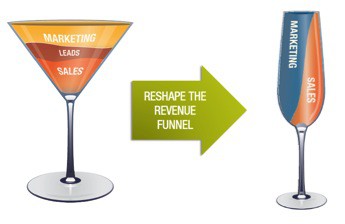How many times have you seen the iconic sales funnel used in a demonstration or sales training? I’m sure more than you can count. If you are like most, this age-old diagram, and the sales psychology it stands for, has molded your understanding of the sales process — it certainly has impacted mine. In its simplest form, the martini glass-shaped sales funnel demonstrates the logic that the more leads you acquire, the more deals you will land.
Sure, this is rational and true, but is it the smartest way to think about acquiring leads? What if the traditional funnel was shaped more like champagne glass, suggesting you could acquire less leads, yet land as many, if not more, wins? (See image above.)
By changing the sales funnel to a champagne flute shape, we are suggesting sales teams spend less time generating demand, and more time capturing and shaping it — engaging qualified leads instead of quantity leads. By taking the time to seek qualified leads within target market segments and accounts (champagne flute), instead of chasing a large quantity of unqualified leads from both target and non-target market segments (martini glass), you can actually reach your goals more quickly and waste less time with leads that are unlikely to convert.
To be clear, for any sales managers reading this, the argument is not that a large quantity of leads is immaterial; rather, focusing so intently on quantity can distract sales professionals from the real objective — REVENUE PERFORMANCE.
Benefits of a Re-Shaped Funnel
The traditional model (martini glass-shaped funnel) is founded on sales professionals using a shotgun approach — covering a wide area, getting as many leads as possible. This approach is focused more on the quantity of leads, instead of quality. Here they may be seeking, let’s say, 100 leads, but because the leads have not been strategically sought out and selected due to their relevance, few will actually result in closed deals.
Instead, the re-shaped funnel suggests sales professionals invest the necessary time to target 10 qualified leads. This method requires them to be prescriptive in the leads they choose, and spend adequate time on the front-end understanding their ideal buyer profile and buyer pains before engaging their lead. Yes, this method takes more time per lead, but by being more strategic and dedicated in going after the right leads, the win rates increase.
Many sales leaders use set metrics to plan on a specific number of deals, (example: you need 330 leads to win 28 deals). This strategy is inefficient. By employing this approach we often force our sales teams into a position of seeking out unqualified leads because, if we are honest with ourselves, there may not even be 330 companies that fit your buyer profile in the assigned territory. Instead of relying upon ratios, help your team identify and engage qualified leads from the start. Engaging only those audiences who align with your buyer profile saves your front line sales team valuable time, as it is a role that marketing and sales operations can partner.
Pursuing Quality Leads from the Start
Investing in quality leads might sound like a good idea, but many teams are left unsure of where to begin. Most marketing and sales teams have habits and leading practices they have been using for years to fill their pipelines — cold calls, webinars, tradeshows and the list goes on. Attempting new methods for finding and engaging leads can be daunting and be time consuming — but remaining stagnant in your pursuit of leads will hurt you over the long haul. Spending more time up-front, preparing your team to engage with the correct profiles, may be just what you need to increase margins and increase sales productivity.
Correct Buyer Profile
One of the biggest mistakes sales and marketing teams can make from the beginning is going after the wrong buyers. Creating a buyer profile will set strategic parameters and provide guidance for teams, enabling them to apply their sales tactics in context of their strategy and ideal buyer. Below are three major components of a successful buyer profile:
- The audience must have fundamental problems your solution addresses.
- The organization should have a problem that is big and bad enough to address.
- The buying persona(s) you are engaging must have the authority to take action.
For more information on buyer profiles, see my post: Derailing the Deal, Part 1: Wrong Buyer Profile
Revenue Performance in Action
Let’s look at a real-world example: A large manufacturer of peripheral technology equipment found its win rates and average sales price deteriorating to the point that they missed their revenue targets for three straight years. Our team worked with them to conduct a go-to-market workshop in which they solidified their target profile, identified the issues their ideal buyers were facing and created the differentiated messaging their sales channels needed to use to communicate a crisp, concise and compelling value proposition. The organization later realized the following game-changing results:
- Pipeline for field sales professionals increased 194% within two months of roll-out; and
- Year-over-year bookings grew 76%.
Re-Shape to Win
While slowing down and taking a step back may seem counterproductive, the time and resource investment to reach quality leads has proven time and time again to be a worthwhile practice. What would it look like to re-shape the sales funnel for your team? Investing in quality over quantity leads will change your day-to-day, but more importantly, it has the potential to increase your overall win-rates. Why not give it a try?
This article was initially written for Top Sales World’s November 2015 Magazine.

